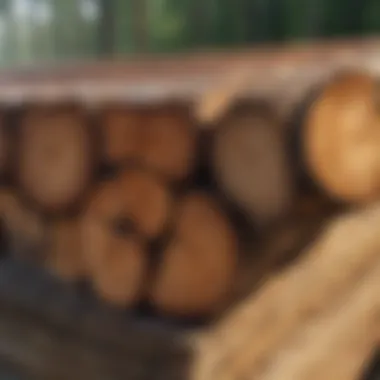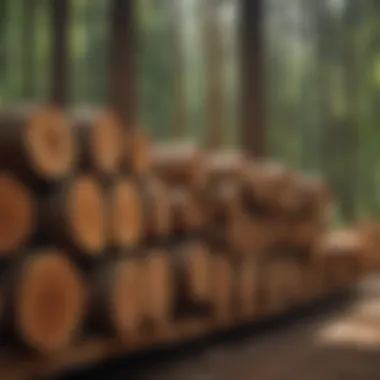Exploring the Benefits and Applications of MCA Treated Lumber


Intro
The importance of understanding the nature and treatment of MCA treated lumber cannot be overstated in today's construction landscape. It plays a crucial role not only in building structures that meet durability standards but also in addressing environmental concerns. MCA, which stands for Micronized Copper Azole, refers to a wood preservative comprised mainly of copper and azole compounds. This chemical composition protects wood from damage caused by insects, fungi, and moisture, ensuring longer-lasting materials for construction.
In this article, we will delve into the specifics of MCA treated lumber, covering the treatment process, the benefits it offers, and the environmental implications that come with its use. This exploration aims to provide forestry professionals and scholars with relevant information that enhances their understanding and application of MCA lumber in various projects.
Understanding Woodland Ecosystems
The forest industry operates within intricate ecosystems where every component is interlinked. Understanding these ecosystems is vital for making informed decisions regarding lumber treatment and sustainability practices
Importance of Biodiversity in Forests
Biodiversity is critical for maintaining the health and resilience of forest ecosystems. Diverse species contribute to the stability of the environment, enhancing its ability to withstand pests and diseases. Forests serve as habitats for numerous species, providing essential resources and maintaining ecological balance. Moreover, rich biodiversity aids in the sustainability of wood production, ensuring a range of species that can be selectively harvested.
Role of Forests in Climate Regulation
Forests play a considerable role in regulating the Earth's climate. They act as carbon sinks, absorbing CO2 from the atmosphere and thus mitigating climate change impacts. This regulation helps in maintaining global temperatures, which is increasingly important in current climate debates. Consequently, how we manage forests, including the type of treatments applied to lumber, can directly influence climate dynamics.
Sustainable Forestry Practices
Sustainable forestry ensures that our forest resources are managed in a way that meets present needs while safeguarding these crucial ecosystems for future generations
Principles of Sustainable Forestry
- Ecological Balance: Managing forestry operations without compromising forest health.
- Societal Needs: Acknowledging and addressing the needs of local communities who depend on forests.
- Economic Viability: Ensuring forestry practices are economically sustainable for stakeholders involved.
Case Studies of Successful Implementations
Several initiatives worldwide exemplify sustainable forestry practices. For example, organizations in Scandinavia have employed selective logging that minimizes habitat disruption. Similarly, certified sustainable timber programs promote practices that enhance the sustainability of harvested wood.
Woodland Stewardship Techniques
Engaging in effective woodland stewardship techniques is essential for ensuring sustainable management of forest resources
Forest Management Plans
A detailed forest management plan serves as a roadmap for managing various aspects of the woodlands. These plans typically include:
- Resource inventory
- Long-term objectives
- Silvicultural practices
- Monitoring and evaluation measures
Conservation Strategies
Implementing conservation strategies is vital for protecting vulnerable ecosystems. Soil conservation methods, biodiversity protection measures, and controlled harvesting practices can all contribute to a healthier forest ecosystem.
"Effective stewardship of woodlands is not just about managing resources; it's about preserving the integrity of the ecosystem for future generations."
In summary, understanding the complexities of MCA treated lumber, from its treatment to ecological impacts, is integral for professionals in the forestry and construction sectors. In the following sections, we will explore the specifics of the chemical composition and treatment process, paving the way for deeper insights into its applications and sustainability concerns.
Understanding MCA Treatment
MCA treatment, or Micronized Copper Azole treatment, represents a significant advancement in the preservation of wood. Understanding it is essential for those involved in forestry and construction, as this treatment not only extends the life of lumber but also addresses various environmental concerns. The implications of MCA treatment are far-reaching, from enhancing durability to enabling safe usage in multiple applications.
Definition and Overview
MCA treatment is a process that involves the infusion of wood with a preservative compound made primarily from copper and azole. This treatment is designed to protect wood from decay, insects, and other forms of damage. By penetrating deeply into the wood fibers, MCA enhances its structural integrity and lifespan, making it suitable for both residential and commercial uses.
The essence of MCA treatment lies in its ability to provide long-lasting protection without being overly toxic to the environment. Unlike some traditional wood preservatives that contain harsher chemicals, MCA treated lumber is viewed as a more eco-friendly option. This attribute makes it particularly attractive for projects that require compliance with stringent environmental standards.
Chemical Composition of MCA
The chemical composition of MCA involves a strategic combination of copper and azole compounds. Copper serves as a fungicide that inhibits fungal growth, while azole acts to protect against insect infestations. The careful balance of these ingredients creates a wood treatment that is both effective and less harmful than many alternatives.
MCA’s micronized form allows for a more uniform distribution throughout the wood, improving its protective attributes significantly. Due to its specific chemical makeup, MCA treated lumber resists mold, termites, and various decay fungi. Such resistance is critical for maintaining the structural and aesthetic quality of wood over time.
To summarize, understanding MCA treatment helps professionals make informed decisions about material choice in their projects. Emphasizing the chemical foundation and the benefits it offers contributes to a broader understanding of how to effectively use this treatment in construction and outdoor applications.
The Treatment Process
Understanding the treatment process of MCA treated lumber is key to grasping its effectiveness and advantages in various applications. This section dissects the techniques and methods involved in treating wood with MCA, ensuring that the readers, particularly forestry professionals and academics, comprehend how these processes enhance the lumber's performance and durability.
Wood Preparation Techniques
Preparing the wood prior to treatment is an essential step that significantly impacts the overall quality of the MCA treated lumber. Proper preparation involves several stages:
- Selection of Wood: Choosing the right species of wood is the first consideration. Softwoods such as southern yellow pine are often used, due to their favorable absorption characteristics.
- Debarking: The bark is removed from the logs to prevent any potential contaminations during the treatment phase. This step also allows for more uniform absorption of the MCA solution.
- Cutting and Sizing: The logs are cut into specific dimensions based on their intended use. Uneven sizes can affect the treatment efficiency and the final product's reliability.
- Drying: Prior to treatment, the wood needs to be adequately dried to reduce moisture content. Excess moisture can hinder the effectiveness of the MCA infusion, making this an important step. This drying can be achieved through air or kiln drying methods.


These preparation techniques are crucial for ensuring that the wood absorbs the MCA chemicals effectively, leading to enhanced durability and longevity of the final product.
MCA Application Methods
Once the wood is prepared, the application of MCA can commence. The methods of application play a significant role in determining how well the treatment will perform. Some common application methods include:
- Pressure Treatment: This is the most common method, where MCA is forced into the wood using high pressure. This ensures deep penetration of the chemical, maximizing protection against termites, decay, and other factors that could weaken the lumber.
- Vacuum Treatment: Similar to pressure treatment but operates under vacuum conditions. This method reduces air pockets in the wood, thus promoting deeper MCA absorption.
- Non-Pressure Processes: This includes dip treatment or brush-on methods. While less effective for larger scale applications, these methods can be suitable for small projects or repairs.
Each application method has its advantages and should be chosen based on specific project requirements.
Drying and Preserving Process
The final stage of the treatment process involves drying and preserving the wood post-MCA application. This step is critical to ensure that the chemicals bond effectively with the wood fibers, providing long-lasting protection.
- Initial Drying: After treatment, wood is often subject to an initial drying phase. This might take place within the treatment facility or in a controlled outdoor environment. This step helps in removing excess moisture that could interfere with the curing of MCA.
- Curing Time: Following drying, a proper curing time is necessary to allow the chemical treatments to stabilize and bond with the wood. Generally, the curing period ranges from several days to weeks, depending on environmental conditions.
- Maintenance of Environment: Maintaining a suitable environment during drying and curing is essential. Factors such as temperature and humidity can affect both the efficacy of the treatment and the final product quality.
By understanding these intricacies in the treatment process of MCA treated lumber, stakeholders can make well-informed decisions in the selection and application of this material for their projects.
"The treatment process not only enhances the performance of the lumber but also ensures that it meets the criteria for various applications in construction and outdoor usage."
For more details on lumber treatment, you may refer to resources such as Wikipedia or Britannica.
Benefits of MCA Treated Lumber
The use of MCA treated lumber offers numerous advantages that make it an important choice in the construction and woodworking industries. Recognizing these benefits helps stakeholders make informed decisions about their projects. This section delves into specific elements such as durability, pest resistance, and cost-effectiveness. Understanding these strengths is crucial, especially for professionals looking to optimize their building materials.
Enhanced Durability
MCA treated lumber stands out for its superior durability. This importance stems from the treatment process, which involves infusing the wood with specific chemicals that enhance its resistance to weathering and physical wear. Unlike untreated lumber, MCA treated options can withstand harsh environmental factors. This characteristic makes them ideal for outdoor projects like decks and fences.
Furthermore, the life expectancy of MCA treated lumber often surpasses that of non-treated alternatives. Customers benefit from longer-lasting structures and a reduced need for replacements, translating into overall cost savings over time. The durable nature of MCA also ensures that structures maintain their integrity even in extreme weather conditions, providing security for builders and users alike.
Resistance to Pests and Decay
Another significant advantage of MCA treated lumber is its strong resistance to pests and decay. This feature is particularly valuable in areas prone to termite infestations or rot. The chemicals used in MCA treatment act not only as preservatives but also as effective deterrents against wood-destroying organisms. This dual function is critical for maintaining the longevity of wooden structures.
Homeowners and builders can reduce the risks associated with pest damage. By opting for MCA treated lumber, they are investing in materials less likely to succumb to decay or infestation. This resistance can lead to fewer maintenance costs, as individuals do not need to engage in frequent repairs or replacements due to these issues. The long-term sustainability of using MCA treated lumber enhances its appeal across different construction applications.
Cost-Effectiveness in Projects
Cost-effectiveness is a vital consideration when selecting materials for construction projects. MCA treated lumber not only boasts durability but also provides an economic advantage. It generally requires fewer resources in maintenance and replacement compared to untreated options. This benefit can make significant financial differences, especially in larger projects.
In addition to reduced maintenance costs, the initial investment in MCA treated lumber may be offset by its extended life span. Builders and homeowners who choose this option can derive long-term savings, making it a wise financial choice. Buyers can also find MCA treated lumber at competitive prices, balancing quality and affordability effectively. It represents a practical solution for those looking to maximize their project budgets while ensuring high-quality results.
"MCA treated lumber combines superior durability with effective pest resistance, making it a sensible choice for long-lasting construction projects."
By understanding these key benefits—enhanced durability, resistance to pests and decay, and cost-effectiveness—professionals in the forestry and construction industries can make informed decisions about using MCA treated lumber in their projects.
Applications in Construction
The significance of MCA treated lumber in construction cannot be overstated. Its intrinsic qualities make it a popular choice across various types of projects. This section will delve into specific applications, highlighting benefits and important considerations. Each segment will illustrate how MCA treated lumber serves to address distinct needs across both residential and commercial sectors, as well as outdoor features like fencing and decking.
Residential Uses
MCA treated lumber finds extensive application in residential construction. Homeowners utilize it for framing, decking, and support structures. One key advantage is its resistance to decay and insects, which prolongs the lifespan of wooden elements exposed to the elements. This durability is a crucial factor for homebuilders and remodelers. Additionally, using MCA treated lumber can help in meeting local building codes that require specific treatment standards for wood used in outdoor settings.
In constructing outdoor decks, the use of MCA treated lumber reduces the risk of deterioration. Homeowners appreciate its aesthetics and reliability. However, it is essential to ensure proper installation and maintenance to maximize the benefits. Regular inspections and re-staining can enhance the attractiveness and longevity of these structures.
Commercial Projects
In the realm of commercial construction, MCA treated lumber is favored for various applications such as framing, outdoor structures, and landscaping features. Businesses benefit from the long-term cost efficiency provided by its resistance to rot and insect damage. This quality is particularly valuable in projects like boardwalks, picnic areas, and playgrounds.
Furthermore, many commercial builders choose MCA treated lumber to adhere to environmental regulations. Its treatment process minimizes harmful chemicals, making it a safer choice for public spaces. Adopting this lumber ensures compliance with health and safety standards, which is a cornerstone in commercial construction.
Fencing and Decking
Fencing and decking are two prominent applications where MCA treated lumber excels. For fencing, MCA treated lumber provides robust security while withstanding the impacts of weather and pests. Additionally, it enables versatile design options, allowing homeowners and builders to create customized appearances that complement any property.
For decking, MCA treated lumber presents a straightforward solution for outdoor spaces. It offers a balance of performance and aesthetics, which suits both residential and commercial clients. The ability to withstand decay ensures a good return on investment, as installed decks maintain their structural integrity over time. Choosing quality MCA treated lumber reduces ongoing maintenance costs related to replacing sagging or rotting boards.
"MCA treated lumber is often a go-to material for projects requiring durability and resistance to the elements. It's not just a choice; it's a commitment to quality and sustainability."
Environmental Considerations
Environmental considerations play a crucial role in the discussion surrounding MCA treated lumber. As the construction industry increasingly focuses on sustainability and ecological responsibility, understanding the environmental impact of materials becomes essential. MCA treatment is designed not only to enhance the durability and performance of wood products but also to address specific environmental concerns that arise from wood preservation methods. This section delves into the implications of MCA treatment on ecosystems and reviews the regulatory guidelines governing its use.


Impact of MCA Treatment on Ecosystems
The impact of MCA treatment on ecosystems is a multi-faceted topic. When considering lumber that has undergone MCA treatment, the potential effects on local flora and fauna are vital. MCA, which stands for Micronized Copper Azole, includes copper and other biocides aimed at reducing decay and pest damage. While copper is less toxic than some traditional preservatives, such as chromated copper arsenate, it still poses certain risks to aquatic life and plants if leached into the soil or water systems.
Some studies suggest that the leaching of copper can affect microbial biodiversity in soil, which is essential for nutrient cycling and plant health. It can also impact aquatic ecosystems when treated wood is used in areas close to water bodies. Thus, construction projects employing MCA treated lumber should consider site-specific conditions and the possible surrounding ecological systems.
"The balance between the benefits of using treated wood and its ecological impacts must be carefully considered in project planning."
Additionally, it is important to implement best practices for installation and disposal. This includes ensuring that treated products are used away from water sources and promoting proper end-of-life recycling or disposal methods to minimize leaching risks.
Regulatory Guidelines and Standards
Regulatory guidelines are critical in ensuring that the use of MCA treated lumber adheres to environmental safety standards. Agencies such as the Environmental Protection Agency (EPA) and the American Wood Protection Association (AWPA) set forth regulations aimed at protecting ecosystems from harmful chemicals in wood treatments.
These standards mandate that only safe levels of copper and other additives be used in the treatment process. They also require proper labeling of treated products to inform users about the handling, usage, and disposal methods of the wood.
Understanding the various guidelines helps stakeholders make informed decisions when selecting treated lumber for construction or landscaping. Common regulations include defining safe distances from water bodies, ensuring that proper installation practices are followed, and the necessity of training for workers involved in handling these products.
In summary, staying updated on current regulations is necessary for minimizing environmental impacts and ensuring safety in the use of MCA treated lumber.
Durability and Longevity
Durability and longevity are crucial factors in evaluating the effectiveness of MCA treated lumber. These attributes directly influence the material's performance and overall value in various applications. Understanding how long MCA treated products last, alongside the elements that affect their performance, is essential for forestry professionals and construction stakeholders alike. Durable lumber ensures that structures maintain integrity while minimizing the need for repairs, which can lead to significant cost savings in the long term.
Life Expectancy of MCA Treated Products
The life expectancy of MCA treated lumber varies, typically ranging from 20 to 40 years depending on several factors. These include environmental conditions, specific applications, and the inherent characteristics of the wood being treated.
Factors that may contribute to this longevity include:
- Quality of wood: Species such as southern yellow pine tend to withstand exposure better.
- Applicaton environment: Exposure to moisture, UV rays, and pests significantly influences durability.
- Proper treatment: Following manufacturer recommendations enhances the effectiveness of the MCA treatment, helping to achieve maximum life expectancy.
MCA treatment is designed to bolster the wood’s ability to resist decay and maintain structural integrity over time. Regardless, regular inspections and maintenance can help identify potential issues before they become severe.
Factors Affecting Performance
The performance of MCA treated lumber is subject to various influences. Understanding these factors can help improve its longevity and adoption in various projects. Key aspects include:
- Moisture levels: High humidity can increase wood's susceptibility to mold and decay. Ensuring proper drainage and ventilation is critical in extended exposure situations.
- Physical stress: The load limits and environmental conditions design must consider. Excessive weight or pressure can compromise the material over time.
- Maintenance practices: Routine care, such as cleaning and sealing, can extend the life of the lumber significantly. An invested approach to maintenance can pay off in longevity.
"Properly maintained MCA treated lumber can exceed its expected life span by many years, enhancing its appeal to buyers and builders."
Understanding durability and longevity in MCA treated lumber is paramount for making informed choices. A combination of good practices and awareness of environmental conditions can substantiate the investment in this type of lumber, leading to successful project outcomes.
Alternatives to MCA Treatment
The consideration of alternatives to MCA treatment is essential within the broader context of sustainable forestry and responsible construction practices. While MCA treated lumber has gained popularity due to its durability and resistance to pests, exploring other wood treatment methods can reveal additional benefits and insights into the best practices for various projects. Understanding these alternatives aids in making informed decisions that align with both environmental goals and construction needs.
Other Wood Treatments
Several wood treatment options exist that can serve as alternatives to MCA. Each method has its unique properties and applications. Some of the most recognized wood treatments include:
- CCA (Chromated Copper Arsenate): This treatment has been utilized for decades and offers significant protection against insects and decay. However, it contains arsenic, raising health concerns and limiting its use in residential projects.
- ACQ (Alkaline Copper Quaternary): A water-based treatment that is less toxic than CCA. ACQ is effective in combating fungi and insects, making it a preferred choice for many applications, especially in residential and urban environments.
- Copper Azole: Similar to ACQ, this treatment uses copper as the primary active ingredient and is regarded as safe for various applications.
- Borate Treatments: These treatments penetrate deep into the wood and provide protection against termites and fungi. They are particularly suitable for indoor applications due to their low toxicity.
- Thermal Modification: This physical process involves heating wood to high temperatures in a controlled environment, enhancing its durability and resistance to decay without the use of chemicals.
By evaluating these alternatives, stakeholders can assess what best suits their specific project needs while considering health and environmental safety.
Sustainability of Alternatives
Sustainability is a pressing consideration when choosing wood treatments. The environmental impacts of each treatment method warrant careful evaluation. Alternatives to MCA treatment can offer various ecological benefits:
- Lower Toxicity: Many alternative treatments, such as ACQ and borate, have less harmful chemicals compared to traditional preservatives, minimizing the risks of groundwater contamination.
- Biodegradability: Some treatments are more biodegradable, allowing them to break down over time without leaving behind harmful residues in the soil or water.
- Reduced Carbon Footprint: Methods like thermal modification require less energy than chemical treatments, thus enhancing the overall sustainability profile of the treated wood.
A holistic approach to selecting wood treatments not only focuses on efficacy but also incorporates long-term environmental impacts. It is critical for professionals in the forestry and construction industries to remain informed about these alternatives to make choices that promote sustainability and ecological responsibility.
"The future of construction relies not only on the strength of the materials but also on their ecological footprint."
Case Studies of MCA Applications
Examining case studies of MCA treated lumber applications provides insight into its practical benefits and challenges in real-world settings. These case studies serve as exemplars of how MCA treated products perform across various scenarios. Understanding these applications is vital for stakeholders, as it offers evidence-based support for decision-making regarding the use of MCA treated lumber in different projects.
Residential Projects
In the residential sector, MCA treated lumber has been employed extensively in multiple applications, including decks, fences, and structural elements such as posts and beams. One notable case study involved a suburban construction project where MCA treated lumber was used for a large deck.
This project highlighted several advantages:


- Durability: Homeowners reported that the MCA treated lumber withstood the harsh weather conditions typical in their region. The treatment effectively protected the wood against rot and insects.
- Aesthetic Appeal: The treated lumber maintained its appearance better than untreated alternatives. Homeowners appreciated the long-lasting finish and the ability to retain colors over time.
- Cost-Effectiveness: Although the initial investment was slightly higher than untreated lumber, the homeowners noted a significant reduction in maintenance costs due to the enhanced durability.
The case demonstrated the long-term performance of MCA treated lumber in residential environments, providing reassurance to future buyers about its sound investment.
Commercial Success Stories
MCA treated lumber has also found success in various commercial projects. A prominent example can be observed in a community park development, where MCA treated products were used for landscape features, picnic areas, and walking paths.
The decision to utilize MCA treated lumber was influenced by several factors:
- Safety and Compliance: Compliance with building codes related to durability and safety was easily achieved. The MCA treatment helped meet the rigorous standards set by local authorities and ensured a safe environment for public use.
- Longevity under Use: Despite heavy foot traffic, the structures built with MCA treated lumber displayed admirable wear resistance. The applications engaged within the park required materials that could endure over time without substantial degradation.
- Sustainable Practices: The project received positive feedback from the community for its commitment to environmental sustainability. By choosing MCA treated lumber, the developers highlighted their dedication to using safer, environmentally-friendly products.
Overall, these case studies show that MCA treated lumber contributes meaningfully to both residential and commercial applications. They shed light on its utility, addressing practicalities such as durability and aesthetics while aligning with safety standards and environmental considerations.
Best Practices for Use
Understanding the best practices for the use of MCA treated lumber is crucial for ensuring longevity and performance in various applications. These practices enable professionals in the forestry and construction industries to maximize the benefits of this material while mitigating potential risks. Following established guidelines not only enhances safety and efficiency but also contributes to environmental stewardship.
Installation Guidelines
Proper installation of MCA treated lumber is fundamental to achieving its intended benefits. Here are key considerations:
- Familiarize with Material Specifications: Ensure the lumber meets the appropriate grade and treatment level for the specific application. Local building codes may dictate certain standards.
- Choose Suitable Tools and Techniques: Using the right tools decreases the chance of damaging the treated surface. For instance, when cutting or drilling, avoid generating excessive heat that might compromise the chemical properties.
- Account for Environmental Conditions: Plan installation during favorable weather conditions. Avoid extreme cold or wetness that may affect adhesive used for fastening or other treated materials.
- Proper Spacing and Supports: Maintain adequate spacing between joists in decking to allow for ventilation. This prevents moisture buildup, which can lead to decay or insect attraction.
- Follow Manufacturer Recommendations: Each product may have specific installation instructions. Following these can ensure the structural integrity of the finished project.
Maintenance Tips
Regular maintenance is vital for preserving the durability and aesthetic appeal of MCA treated lumber. Here are essential tips:
- Regular Inspections: Schedule periodic evaluations for signs of wear, discoloration, or insect damage. Early detection can prevent extensive repairs.
- Cleaning: Use a mild detergent and water to clean the surface annually. Remove debris, dirt, and organic matter to avoid moisture retention.
- Reapplication of Protective Coatings: Depending on the application, consider using penetrating sealers every few years to maintain the wood's resistance to moisture and UV degradation.
- Monitor for Moisture Accumulation: Ensure proper drainage around structures made with MCA lumber. Standing water can accelerate decay and diminish the lumber's lifespan.
- Avoid Direct Ground Contact: If possible, use spacing to keep the lumber elevated. This decreases the likelihood of rot from soil exposure.
By adhering to these best practices, users can enhance the effectiveness of MCA treated lumber, ensuring it serves well in both structural and aesthetic roles.
Expert Insights and Opinions
Understanding expert insights and opinions about MCA treated lumber is crucial for various stakeholders in the forestry and construction industries. Experts provide context based on their experience and research, helping to deepen the knowledge around this topic. Their insights can influence decisions regarding the use, application, and developments within the realm of treated lumber, illustrating both longstanding practices and emerging trends.
Interviews with Industry Leaders
Interviews with industry leaders shed light on the real-world applicability of MCA treated lumber. These conversations often reveal how professionals perceive the wood treatment process and its outcomes. Leaders may discuss successful projects where MCA treated lumber has been utilized, highlight challenges they faced, or outline expectations from suppliers.
Such interviews can offer invaluable information regarding:
- Innovative Approaches: Many industry leaders share innovative methods of using MCA treated lumber that they have developed, which can enhance its performance.
- Market Trends: Their perspectives can provide data about consumer preferences and trends in material choices across different regions.
- Challenges in Implementation: Leaders often discuss regulatory challenges that may affect the availability and application of MCA treated lumber.
For instance, an interview with a project manager from a construction firm may reveal that since switching to MCA treated lumber, construction timelines have improved due to fewer delays from pest infestations. Such insights can guide other professionals considering similar materials.
Research Findings on Efficacy
Research findings on the efficacy of MCA treated lumber add a scientific backdrop to expert discussions. Various studies evaluate how well MCA treated products perform under different environmental conditions. This research often addresses key variables such as:
- Resistance to Fungal Decay: Studies have shown that MCA treated lumber significantly outperforms untreated wood when exposed to wet environments.
- Longevity of Treatments: Research indicates the expected lifespan of MCA treated products can exceed those of traditional treatments, thus promoting long-term cost savings.
- Environmental Impact: Many studies are also focusing on comparing the environmental footprint of MCA treated lumber with alternative wood treatments, indicating a generally lighter environmental load associated with MCA.
Research has demonstrated that properly treated MCA lumber has a lifespan of up to 40 years, provided it is installed correctly and maintained.
When examining efficacy, stakeholders can feel more confident making informed decisions about adopting MCA treated lumber in their projects. These studies not only validate the use of MCA but also encourage ongoing developments in treatment technology. Thus, combining expert opinions with rigorous research creates a comprehensive understanding that can help the industry advance.
Future of MCA Treated Lumber
The future of MCA treated lumber is crucial as it determines how this material adapts to changing market demands, technological advancements, and environmental concerns. As we face the challenges of climate change and the increasing need for sustainable building materials, understanding these future trends plays a key role in guiding the forestry and construction industries towards sustainable practices.
Emerging Technologies in Treatment
Advances in treatment methodologies are evolving rapidly. New technologies are emerging that enhance the effectiveness and safety of MCA treatment. Innovations such as nano-coating and modified treatments that combine multiple preservation principles are on the horizon. These emerging techniques not only improve the durability of lumber but also minimize any potential environmental impact by using fewer harmful substances.
Utilizing new technologies can lead to treatments that are more efficient in application. For example, some research focuses on automated systems capable of applying treatment agents in a more controlled manner. This development could improve the consistency of application and reduce wastage, ultimately enhancing the quality of the treated lumber. It is important to monitor these advancements as they could redefine standards in the treatment process and result in enhanced products over time.
Trends in Sustainable Practices
The shift towards sustainability is becoming increasingly significant across the timber industry. Several trends are emerging that reflect this movement, affecting MCA treated lumber as well.
- Utilization of Renewable Resources: The industry shows a growing preference for sourcing wood from sustainably managed forests. This ensures that the environmental footprint of obtaining lumber is minimized.
- Increased Transparency: Consumers and builders are demanding more information about the products they use. Manufacturers are encouraged to provide detailed information about chemical compositions and protocols used in the treatment process.
- Lifecycle Assessment: Understanding the full environmental impact of a product, from production to disposal, is gaining importance. This involves scrutinizing the long-term effects of treatments and focusing on sustainability from beginning to end.
- Collaborations for Sustainability: Industry players are increasingly forming partnerships with environmental organizations. These collaborations aim to establish best practices and promote the use of treated products that are sustainable and safe for use.
Culmination
The exploration of MCA treated lumber highlights significant aspects relevant to current and future practices in the forestry and construction industries. Understanding this subject is crucial for professionals looking to make informed choices regarding materials that are both sustainable and durable. With the rising importance of environmentally-friendly practices, MCA treatment offers a viable solution that balances effectiveness and ecological considerations.
Summary of Key Points
MCA treated lumber offers notable benefits, including
- Enhanced resistance against pests and decay,
- Improved longevity compared to untreated wood,
- Cost-effective solutions for construction projects.
The article discussed the chemical composition of MCA, the detailed treatment processes, and the wide array of applications in various construction settings. Additionally, it examined the environmental implications of using MCA treated wood, including regulations that inform best practices.







